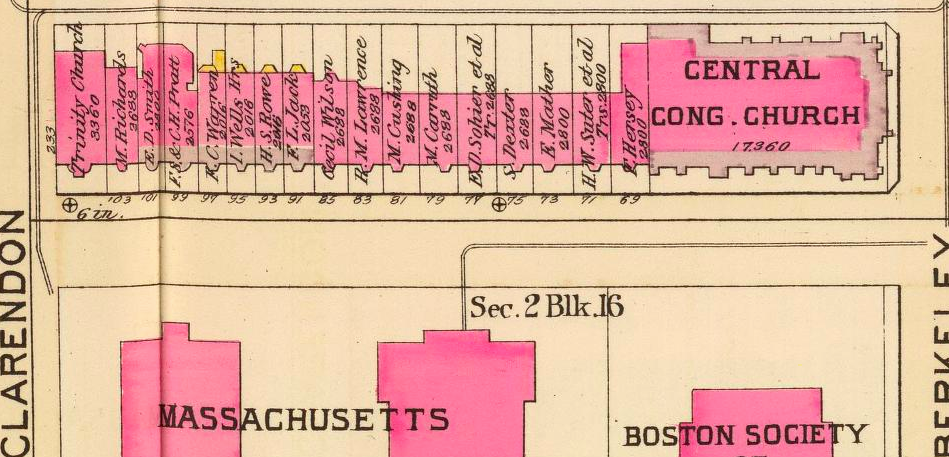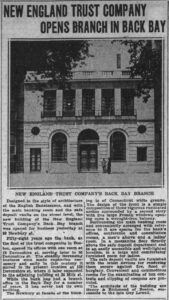 Today, the NEHGS headquarters at 99—101 Newbury Street stands eight stories tall, several stories higher than the neighboring buildings. However, the present building at 99—101 Newbury was not always the tallest on the block. It began as a three-story bank building.
Today, the NEHGS headquarters at 99—101 Newbury Street stands eight stories tall, several stories higher than the neighboring buildings. However, the present building at 99—101 Newbury was not always the tallest on the block. It began as a three-story bank building.
After the Back Bay was filled in during the second half of the nineteenth century, a new neighborhood sprang up, filled by desirable Victorian brick rowhouses. Newbury Street was no different. It had been built up by 1890 and families had moved in. Numbers 99 and 101 Newbury Street were two separate residences (though attached, like all the other row homes in the area) which faced the Massachusetts Institute of Technology buildings across the street.
Early residents of the 99 Newbury residence were Sophia Grace Robbins Potter and Henry Staples Potter. After the Potter family came the Pratts. The Pratts sold their home to Clara Nelson in 1904, when it was described as “one of the finest estates on Newbury St., consisting of a four-story swell-front brick house and 2576 feet of land.”[1] The house changed hands a few more times, and in 1922 Boston University leased part of the building to use as offices for its College of Business Administration.[2]
"[One] of the finest estates on Newbury St., consisting of a four-story swell-front brick house and 2576 feet of land.”
Next door at 101 Newbury Street, the Mott-Smiths had moved in by 1890. Like its neighbor, 101 Newbury was home to several families over the next two decades. By 1923, the Boston University College of Business Administration’s “girls’ clubrooms” were located at that address.[3]
However, in April 1924 both lots were purchased by Henry G. Brookings. Soon after—Brookings’s role in this is not clear—the buildings were torn down. On that site rose the new branch of the New England Trust Company.
The new branch office, designed by architects Ralph Coolidge Henry and Henry P. Richmond in a Renaissance Revival style, would “house under one roof complete banking facilities for those who require uptown banking services.” The building was said to be one of “unusual beauty” with “many refinements.”[4] When the office opened in the summer of 1929, it was touted as a place where customers would find both comfort and convenience, and was also noted for its top-of-the-line security devices. The Boston Globe reported on the installation of the 28,000-pound fireproof bank vault door.[5]
In 1963, NEHGS purchased the building and turned the three-story bank into an eight-story library and office building. The Society moved into its new home the following year, and has now been going fifty-six years strong on Newbury Street.
Notes
[1] “The handsome residence…,” Boston Globe, 17 February 1904, 3.
[2] “Boston University has Department Moving Day,” Boston Globe, 23 March 1922, 10.
[3] “Dinner Party and Social on Wednesday Evening,” Boston Globe, 26 February 1923, 2.
[4] “Crowd Watches Installation of Door Weighting 28,000 Pounds,” Boston Globe, 7 May 1929, 16.
[5] Ibid., and “New England Trust Company Opens Branch in Back Bay,” Boston Globe, 29 June 1929, 18.
Share this:

About Hallie Kirchner
Hallie Kirchner is a genealogist and part of the team that performs research-for-hire for patrons. In addition to working with patrons to answer their family history questions, Hallie also helps with the Ask-A-Genealogist chat service and has worked on a variety of educational programs during her time at American Ancestors. Her areas of expertise include 19th-century America, Germany, and immigration.View all posts by Hallie Kirchner →
